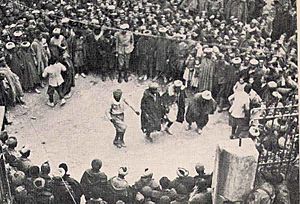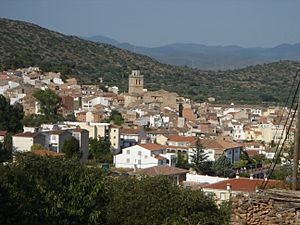Levante Offensive facts for kids
Quick facts for kids Levante Offensive |
|||||||
|---|---|---|---|---|---|---|---|
| Part of the Spanish Civil War | |||||||
 Moroccan troops in Rubielos de Mora, 1938. |
|||||||
|
|||||||
| Belligerents | |||||||
| Commanders and leaders | |||||||
| Strength | |||||||
| 125,000 | 125,000 900–1,000 artillery 400 aircraft |
||||||
| Casualties and losses | |||||||
| 5,000 | 20,000 | ||||||
The Levante Offensive was a major military push by the Nationalist forces during the Spanish Civil War. It began in late March 1938. The goal was to capture the city of Valencia, which was held by the Republican side.
The Nationalists managed to take over the province of Castellón. However, their attack failed. This was mainly due to bad weather and the strong defense put up by the Republican troops. These defenders were positioned along a special defense line called the XYZ Line.
Contents
Why the Offensive Started
After the Aragon Offensive, the Nationalist armies reached the Mediterranean Sea. This split the Republic into two parts. The Spanish Republican Army was in a difficult situation. The path to Barcelona seemed open for the Nationalists.
Even General Vicente Rojo, a Republican leader, thought Barcelona could have been taken easily. However, Francisco Franco, the Nationalist leader, made a different choice. He decided to turn south and attack Valencia instead. Valencia was the capital of the Spanish Republic at that time.
Franco was worried that France might get involved if he attacked Catalonia. Also, he didn't want the war to end too quickly. He wanted to completely defeat the Republic. This way, he could crush all opposition. A long war meant a total victory for him.
The Nationalist Attack Begins
The Nationalist attack started on April 25, 1938. General José Enrique Varela's army, Antonio Aranda's forces, and Garcia Valiño's group led the charge. But their advance quickly stopped on April 27.
On May 1, the Nationalists tried again. They moved forward on three different fronts. One group came from Teruel (Varela). Another moved along the Mediterranean coast (Aranda). A third group went through the mountains in the middle (Garcia Valiño).
Their progress was slow. Heavy rain in March and April made the ground muddy. The difficult mountain terrain also helped the Republican defenders. The Republican troops fought very hard. They had also received new weapons from France. These included Soviet Supermosca (I-16 Type 10) fighter planes and anti-aircraft guns.
On June 13, Castellón fell to Garcia Valiño's forces after several days of fighting. This gave the Nationalists a port on the Mediterranean Sea. They could now bring in supplies and food more easily. However, they were stopped just before reaching Sagunto. Here, the Sierra de Espadán mountains came very close to the sea, creating a strong defensive position.
The Nationalists were surprised by how strongly the Republicans fought back. General Alfredo Kindelán even tried to convince Franco to stop the operation. The Condor Legion, a German air force unit, was tired and pulled out of the front lines.
Despite this, Franco ordered the attack to continue. He wanted Valencia captured by July 25. By early July, the Nationalists brought in more troops. These included three divisions from the Corpo Truppe Volontarie (CTV), led by General Mario Berti. They also had four divisions from General José Solchaga's Turia Corps.
The Nationalists now had 900 cannons and 400 aircraft. They had also just received about 50 Italian medium bombers. The Republicans faced them with six different army corps. These forces were part of General Leopoldo Menéndez's Army of the Levante.
On July 5, Garcia Valiño attacked from Castellón. But he was stopped by Republican forces led by Colonel Gustavo Duran and General Menendez. This happened at the Sierra de Espadan mountains. The final big push by the Nationalists began on July 13.
To the west, Solchaga's corps moved south from Teruel. Varela's corps and the Italian CTV were on their eastern side. The Garcia Valiño group tried to advance along the coast. After tough fighting at Mora de Rubielos and Sarrion, the Republican line in the Sierra del Toro broke.
The Nationalists then advanced about 60 miles. Their front was 20 miles wide. But they were finally stopped by the strong fortifications of the XYZ Line. This line stretched from Viver east and west into the Sierra de Espadan.
The Battle for the XYZ Line
Between July 18 and 23, the XYZ Line defenses successfully stopped the Nationalist advance. Two Republican corps, led by Colonels Ernesto Güemes and Carlos Romero, held these defenses.
The Nationalists tried to break through with many infantry attacks and heavy bombing. But the Republican defenders used well-planned trenches. They also had protected communication lines. This allowed them to cause heavy losses for the Nationalists. About 20,000 Nationalist soldiers were killed or wounded. The Republicans suffered far fewer casualties, only about 5,000.
By July 23, the Nationalist attack was slowing down. On July 24, the Republicans launched a new offensive in the north. This was the Battle of the Ebro. This battle drew away eight Nationalist divisions and their heavy artillery. This prevented any more attacks on the XYZ Line. The Nationalist offensive ended less than 40 kilometers from Valencia.
What Happened Next
The defense of the XYZ Line was a huge victory for the Republic. Some historians say it was even more important than the Battle of Guadalajara. The Nationalists did take the Province of Castellón. However, they failed to capture Valencia and suffered many casualties.
This gave the Republican Army time to get organized again. They were also able to plan their attack across the River Ebro. Furthermore, the Republican forces in Catalonia had time to get new weapons. These weapons came across the French border, which had reopened in March.
See also
 In Spanish: Ofensiva del Levante para niños
In Spanish: Ofensiva del Levante para niños
- List of Spanish Republican military equipment of the Spanish Civil War
- List of Spanish Nationalist military equipment of the Spanish Civil War
- List of weapons of the Corpo Truppe Volontarie
- Condor Legion


